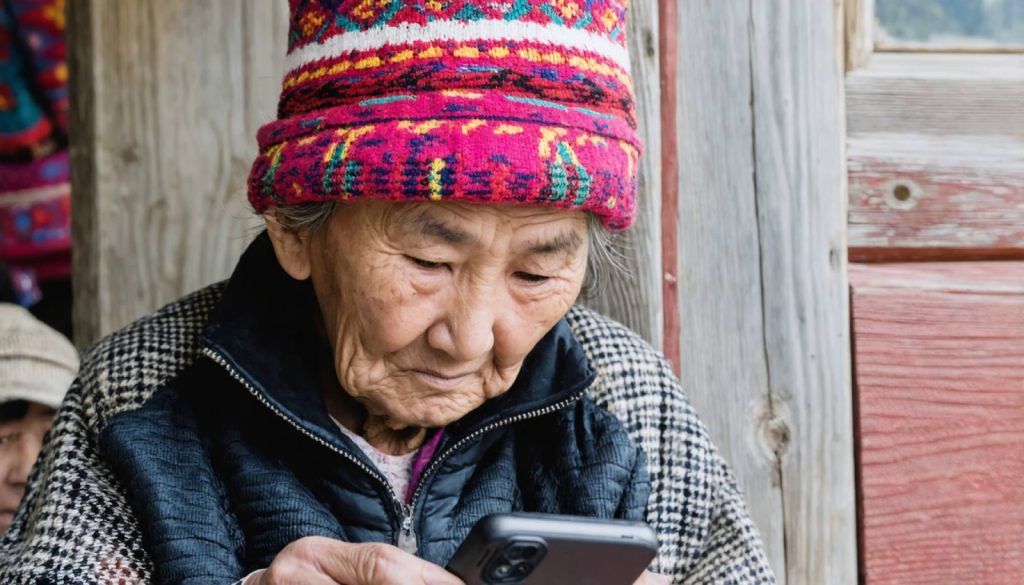
- Balykchy, a town in Kyrgyzstan, balances tradition with the encroachment of modernity, highlighted by elder gatherings in the former school building.
- The Balykchy Older People’s Association provides companionship for elders seeking genuine human connection, counteracting the loneliness intensified by modern digital communication.
- Smartphones serve as essential yet secondary tools for these elders, who prefer face-to-face interactions over digital conversations.
- The elders express concern over younger generations losing conversational skills and cultural heritage due to the prevalence of digital communication.
- The community grapples with integrating new technological advances while preserving cultural identity, reflecting broader global tensions.
- Balykchy’s experiences mirror the universal challenge of maintaining traditional narratives amid burgeoning digital influences.
As the snow-capped peaks of the Tian Shan mountains cradle the town of Balykchy on Lake Issyk Kul’s shores, a curious paradox thrives. Here, where tradition entwines with clumsy steps toward modernity, the older generation stands watchful, clinging to their tales like lifeboats amidst a sea of digital waves. The cavernous space of the town’s former school, once echoing with the lively education of Soviet years, now shelters the Balykchy Older People’s Association. These elders, stewards of history, gather not out of necessity, but out of a hunger for genuine connection—a balm for the solitude that often accompanies advancing years in a world speeding toward future horizons.
In the background, the hum of new Chinese factories tugs the town toward economic rebirth, yet for the elders, the pull of human contact outweighs the allure of sleek technology. The ubiquitous smartphones that have crept into every pocket serve as threadbare links to distant family and friends during darker days such as those enforced by the harsh isolation of the Covid pandemic. Members recall those difficult months when the virus tightened its grip, leaving them housebound but not voiceless. From behind closed doors, messages zipped through the ether, words of comfort and instructions for safety whispered in binary.
Despite their utility, smartphones remain peripheral in these elders’ lives, secondary to the face-to-face conversations that form the heart of their existence. Alexandre, the group’s lone gentleman, often jests with his female companions, indulging in bouts of good-natured teasing. While their fingers occasionally glide over screens, they do not burrow there, preferring stories that unfurl as woven tapestries, rich with laughter and shared memories.
Yet, beneath the surface, a tension simmers. “Do young people know how to have a conversation today?” one member muses, her words a lament wrapped in wistfulness. The digital shorthand of emojis and fragments puzzles her, replacing the warmth of spoken words with distanced exchanges. Eyes drift to their grandchildren when they return from far-off lands. Faces that once lit up with familial tales now glow blue from phone screens, lost in the digital din.
Tradition flows like a whispered river through Kyrgyzstan, with stories the stones over which history and culture together ripple. This generational relay faces disruption as the allure of instant yet shallow connection threatens to unmoor the youth from the rich anchorage of their heritage. The incongruities deepened further by stories of violence echoing through the town, acts seemingly seeped in the unease that external influences and social media trails behind.
As Balykchy watches the sunrise paint the lake anew, an existential question lingers. How might a society embrace the promise of technology while safeguarding its soul from being scattered and silenced? It is a sentiment shared across the world as connections both bind and unravel us. Here, as everywhere, the elders’ hopes lie in balancing progress with precious narratives that sustain identity—an endeavor as expansive and profound as lapping waves against an ancient shore.
How Balykchy’s Elders Balance Tradition and Technology
Preserving Culture in the Face of Modern Technology
The town of Balykchy, nestled on the shores of Lake Issyk Kul, is a microcosm of the larger global struggle to balance tradition with technological advancement. Its elders gather at the Balykchy Older People’s Association, where they strive to maintain communal connection and the richness of face-to-face storytelling amidst the encroaching influence of digital devices.
The Role of Technology: Utility vs. Intrusion
While modern conveniences like smartphones have penetrated daily life, providing critical links to family and friends during the isolating COVID-19 pandemic, they remain secondary among these elders. For them, technology serves a specific function rather than becoming the centerpiece of their interactions, offering utility during difficult times but never replacing the depth of personal conversation.
Cultural Concerns and Generational Gaps
One notable concern expressed by the elders is the apparent disintegration in conversational skills among younger generations. The proliferation of digital shorthand and reliance on screen time foster a growing disconnect with the storytelling tradition that has historically been the bedrock of Kyrgyz culture. By embedding themselves in screens, the youth risk severing ties to their cultural heritage, a concern that reverberates across the world.
Real-World Implications and Trends
This cultural tension mirrors larger global trends where the digitization of interaction threatens cultural traditions. Across various societies, there is an ongoing conversation regarding how to incorporate technology responsibly while preserving cultural identity. As more towns like Balykchy are drawn into the global economy—highlighted by the economic changes brought by new Chinese factories—finding a balance becomes more vital.
How-To: Balancing Technology and Tradition
For communities like Balykchy, the path to harmonizing modern advancements with cultural preservation can be guided by the following steps:
1. Fostering Intergenerational Dialogue: Create platforms where the youth and elders can engage in cultural exchanges, blending storytelling with tech-based projects that preserve history.
2. Promoting Digital Literacy with a Cultural Focus: Encourage the creation of apps or digital platforms that contain traditional stories and cultural teachings, making them accessible to the digitally inclined younger generation.
3. Community Events and Cultural Workshops: Host regular events to celebrate traditional crafts, music, and stories, inviting technological input when appropriate to enhance reach and engagement.
4. Mindful Screen Use Practices: Educate on the healthy balance of screen time with personal interactions, emphasizing the value of direct communication.
Controversies and Limitations
While digital tools can democratize access to information, they also present the risk of cultural homogenization and the spread of misinformation. Carefully curated content and media literacy education are crucial for curbing potential negative impacts.
Conclusion and Recommendations
To navigate the confluence of tradition and technology, it’s essential to foster innovation that respects cultural identities. Initiatives that bridge generational gaps while protecting cultural narratives will serve communities like Balykchy—and indeed the world—by creating a tapestry rich in both technological advancement and historical depth.
For further reading on safeguarding culture in the digital age, visit UNESCO.
Quick Tips for Embracing Change Responsibly
– Encourage face-to-face interactions alongside digital communication.
– Invest in educational programs that marry technology and cultural heritage.
– Foster community discussions on the impacts of technology on cultural practices.
Through these efforts, communities can aim to gain the best of both worlds, nurturing a future where tradition and progress coexist harmoniously.



